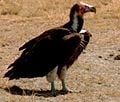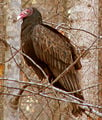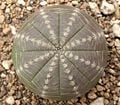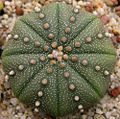Difference between revisions of "Convergent evolution" - New World Encyclopedia
Rick Swarts (talk | contribs) |
Rick Swarts (talk | contribs) |
||
| Line 1: | Line 1: | ||
{{Contracted}} | {{Contracted}} | ||
| − | In [[evolutionary biology]], '''convergent evolution''' or '''convergence''' is the | + | In [[evolution|evolutionary biology]], '''convergent evolution''' or '''convergence''' is the independent development of similar structures, forms, [[physiology]], or behavior in organisms that are not closely related; that is, the [[evolution]] of a similar trait in diverse organisms that is attributed to a reason(s) other than sharing the trait in a common ancestor. An example of convergent evolution is the similar nature of the flight/[[wing]]s of [[insect]]s, [[bird]]s, [[pterosaur]]s, and [[bat]]s. All four wings serve the same function and are similar in form, but each are considered to have evolved independently. |
| + | In [[cultural evolution]], ''convergent evolution'' is the independent development of similar cultural adaptations to similar environmental conditions by different peoples with different ancestral cultures. | ||
| − | + | Broadly defined, evolution is any heritable change in a population of organisms over time. However, the term evolution is often used with the more narrow meaning of the theory that all organism descended from common ancestors (which is known as the "[[evolution#theory of descent with modification|theory of descent with modification]]"). This deals with the ''pattern'' of evolution. Less frequently, evolution is used to refer to one explanation for the pattern, the "[[evolution#theory of natural selection|theory of modification through natural selection]]." This deals with the ''process'' of evolution. | |
| + | In respect to convergent evolution, the phrase likewise can refer to the observed pattern without regard to the process or it can refer to the process involving [[natural selection]]. An example of the later would be defining convergent evolution as the process whereby organisms not closely related independently evolve similar traits as a result of having to adapt to similar environments or [[ecological niche]]s. However, diverse causes theoretically are possible, including design by a Creator,rather than natural selection, whether or not descent with modification is accepted (that is, later forms coming on the foundation of earlier forms). Of course, on a molecular level, convergent evolution can happen due to random mutation unrelated to adaptive changes. | ||
| − | + | Structures that are the result of convergent evolution are called '''[[analogy (biology)|analogous]] structures''' or '''homoplasies'''; they should be contrasted with [[homology (biology)|homologous]] structures that have a common origin. The terms analogy and homology were actually coined by [[Richard Owen]] in the 1840s, prior to [[Charles Darwin|Darwin]]'s theory of evolution, with homology classically defined as similarity in structure and position (such as the pattern of [[bone]]s in a bat's wing and those in a porpoise's flipper) and ''analogy'' signifying functional similarity (such as the wings of a bird and those of a [[butterfly]]). | |
| − | + | Convergent evolution is similar to, but distinguishable from, the phenomena of [[evolutionary relay]] and [[parallel evolution]]. ''Evolutionary relay'' refers to independent species acquiring similar characteristics through their evolution in similar ecosystems, ''but not at the same time'' (e.g. [[dorsal fin]]s of extinct [[ichthyosaur]]s and [[shark]]s). ''Parallel evolution'' occurs when two independent species evolve together ''at the same time in the same [[ecospace]]'' and acquire similar characteristics ([[extinct]] browsing-horses and extinct [[Palaeotherium|paleothere]]s). | |
| − | |||
| − | |||
| − | |||
| − | |||
| − | |||
| + | ==Animal examples== | ||
| + | There are numerous examples of animals that have traits that are attributed to convergent evolution. For example, an [[ichthyosaur]] ([[reptile]]), [[dolphin]] ([[mammal]]), and a [[shark]] ([[fish]]) all have similar form in terms of a streamlined body, bilobed tail, dorsal fins, and pectoral flippers (Luria et al. 1981). Many extant marsupials resemble placentals in appearance. For example, the marsupial Tasmanian "wolf" (''Thylacinus'') resembles its placental counterpart, the wolf (''Canis''), the marsupial "mouse" (''Dasycerus'') resembles the placental mouse (''Mus''), and the marsupial "anteater" (''Myrmecobius'') resembles the placental anteater (''Myrmecophaga'') (Mayr 2001). Evolutionists hold this to be an example of independent, convergent evolution. | ||
| − | |||
| − | |||
| − | |||
| − | |||
| − | |||
| − | |||
| − | |||
| − | |||
| − | |||
| − | |||
;Mammals | ;Mammals | ||
| − | * The [[marsupial]] | + | * The [[marsupial]] Thylacine and [[placental]] [[Canids]]. |
<gallery> | <gallery> | ||
| − | Image:Thylacine.jpg|[[Thylacine]], a canine-like marsupial | + | Image:Thylacine.jpg|[[Thylacine]]*, a canine-like marsupial |
| − | Image:Golden_Jackal_sa02.jpg|[[Golden Jackal]], a true canine | + | Image:Golden_Jackal_sa02.jpg|[[Golden Jackal]]*, a true canine |
</gallery> | </gallery> | ||
| − | *Several mammal groups have independently | + | *Several mammal groups are considered to have independently originated prickly protrusions of the skin, called spines - [[echidna]]s ([[monotreme]]s), [[hedgehog]]s ([[Insectivora|insectivores]]), Old World porcupines ([[rodent]]s) and New World porcupines (a separate group of rodents). In this case, because the two groups of porcupines are relatively closely related, they would be considered to be an example of parallel evolution; neither echidnas nor hedgehogs, however, are closely related to rodents at all. In fact, the last common ancestor of all four groups is considered to have been a contemporary of the dinosaurs. |
| − | * Cat-like, sabre-toothed predators | + | * Cat-like, sabre-toothed predators developed in three distinct lineages of mammals—[[sabre-toothed cat]]s, Nimravids (false sabre-tooths), and the marsupial thylacosmilids. |
| − | * A number of mammals have developed claws and long, sticky tongues that allow them to open the homes of social insects (e.g. | + | * A number of mammals have developed claws and long, sticky tongues that allow them to open the homes of social insects (e.g. [[ant]]s and termites) and eat them. These include the four species of [[anteater]], about 20 species of [[armadillo]], eight species of [[pangolin]], the African [[aardvark]], four species of [[echidna]], and the Australian [[numbat]]. |
| − | * [[Koalas]] of Australasia have | + | * [[Koalas]] of Australasia have fingerprints that are very similar to those of humans. The Australian [[honey possum]]* has developed a long tongue for taking nectar from flowers, the same sort of structure that [[butterfly|butterflies]] possess to accomplish the same task. |
;Birds | ;Birds | ||
| − | * The [[Little Auk]] of the north [[Atlantic Ocean|Atlantic]] ( | + | * The [[Little Auk]]* of the north [[Atlantic Ocean|Atlantic]] (Charadriiformes) and the diving petrels of the southern oceans (Procellariiformes) are remarkably similar in appearance and habits. |
| − | * The similar evolution of [[auk]]s in the [[Northern Hemisphere]] and [[penguin]]s in the [[Southern Hemisphere]]. | + | * The similar evolution of [[auk]]s in the [[Northern Hemisphere]]* and [[penguin]]s in the [[Southern Hemisphere]]*. |
| − | * [[Vulture]]s come in two varieties as a | + | * [[Vulture]]s come in two varieties, assumedly as a function of convergent evolution: both [[Old World vultures]]* and [[New World vultures]]* eat carrion, but Old World vultures are in the eagle and hawk family and use ''eyesight'' for food discovery; the New World vultures are related to storks and use the sense of smell (as well as sight) to find carrion. In both cases they search for food by soaring, circle over carrion, and group in trees, and both have featherless necks. |
<gallery> | <gallery> | ||
Image:Nubianvulture.jpeg|[[Nubian vulture]], an Old World vulture | Image:Nubianvulture.jpeg|[[Nubian vulture]], an Old World vulture | ||
Image:Turkey_vulture_profile.jpg|[[Turkey vulture]], a New World vulture | Image:Turkey_vulture_profile.jpg|[[Turkey vulture]], a New World vulture | ||
</gallery> | </gallery> | ||
| − | * The [[Flightless Cormorant]] of the [[Galapagos Islands]], unlike other [[cormorant]]s, now has wings developed for swimming rather than flight, equal in proportion to | + | * The [[Flightless Cormorant]]* of the [[Galapagos Islands]], unlike other [[cormorant]]s, now has wings developed for swimming rather than flight, equal in proportion to [[penguin]]s. |
;Other | ;Other | ||
| − | * The similarities in diet and activity patterns between the [[thorny devil]] (''Moloch horridus'') and the [[Texas horned lizard]] (''Phrynosoma cornutum'') both in different [[clades]]. | + | * The similarities in diet and activity patterns between the [[thorny devil]]* (''Moloch horridus'') and the [[Texas horned lizard]]* (''Phrynosoma cornutum''), both in different [[clades]]*. |
| − | * The [[Neotropic]]al [[poison dart frog]] and the [[Mantella]] of [[Madagascar]] have independently developed similar mechanisms for obtaining [[alkaloid]]s from a diet of [[ant]]s and storing the toxic chemicals in skin glands. They have also independently evolved similar bright skin colors that warn predators of their toxicity& | + | * The [[Neotropic]]al [[poison dart frog]]( and the [[Mantella]]* of [[Madagascar]] have independently developed similar mechanisms for obtaining [[alkaloid]]s from a diet of [[ant]]s and storing the toxic chemicals in skin glands. They have also independently evolved similar bright skin colors that warn predators of their toxicity—(by the opposite of [[crypsis]]*, namely [[aposematism]]*). |
| − | * | + | * Assassin spiders are a group comprising two lineages that arose independently. They have very long necks and fangs proportionately larger than those of any other spider, and hunt other spiders by snagging them from a distance. |
| − | * The smelling organs of the terrestrial [[coconut crab]] are similar to those of insects. | + | * The smelling organs of the terrestrial [[coconut crab]]* are similar to those of insects. |
| − | * The prehistoric fish-like reptile [[Ophthalmosaurus]] and the aquatic mammal [[ | + | * The prehistoric fish-like reptile [[Ophthalmosaurus]]* and the aquatic mammal [[dolphin]]s and [[tuna]] |
| − | * The [[ | + | * The [[brachiopod]]s and bivalve [[mollusk]]s, which both have very similar shells |
==Plant examples== | ==Plant examples== | ||
| − | * | + | * Prickles, thorns and spines are all modified plant tissues that have seemingly developed to prevent or limit [[herbivory]]; these structures have evolved independently a number of times. |
| − | * The aerial rootlets found in [[ivy]] (''Hedera'') are similar to those of the | + | * The aerial rootlets found in [[ivy]] (''Hedera'') are similar to those of the Climbing Hydrangea (''Hydrangea petiolaris'') and some other [[vine]]s. These rootlets are not derived from a common ancestor but have the same function of clinging to whatever support is available. |
| − | *'' | + | *''Euphorbia'' and many Cactaceae species both occur in hot, dry environments (see picture below) and have similar modifications. |
<gallery> | <gallery> | ||
| − | Image:E_obesa_symmetrica_ies.jpg|'' | + | Image:E_obesa_symmetrica_ies.jpg|''Euphorbia obesa'' |
| − | Image:Astrophytum asterias1.jpg|'' | + | Image:Astrophytum asterias1.jpg|''Astrophytum asterias'' |
</gallery> | </gallery> | ||
| Line 72: | Line 61: | ||
* Rasmussen, L.E.L., Lee, T.D., Roelofs, W.L., Zhang, A., Doyle Davies Jr, G. (1996). Insect pheromone in elephants. Nature. 379: 684 | * Rasmussen, L.E.L., Lee, T.D., Roelofs, W.L., Zhang, A., Doyle Davies Jr, G. (1996). Insect pheromone in elephants. Nature. 379: 684 | ||
*[http://cas.bellarmine.edu/tietjen/Evolution/convergent_evolution_examples.htm Convergent Evolution Examples- Ecological Equivalents], Department of Biology, Bellarmine University | *[http://cas.bellarmine.edu/tietjen/Evolution/convergent_evolution_examples.htm Convergent Evolution Examples- Ecological Equivalents], Department of Biology, Bellarmine University | ||
| − | + | ||
| + | Mayr | ||
| + | Luria | ||
[[Category:Life sciences]] | [[Category:Life sciences]] | ||
{{credit|119762853}} | {{credit|119762853}} | ||
Revision as of 22:58, 27 April 2007
In evolutionary biology, convergent evolution or convergence is the independent development of similar structures, forms, physiology, or behavior in organisms that are not closely related; that is, the evolution of a similar trait in diverse organisms that is attributed to a reason(s) other than sharing the trait in a common ancestor. An example of convergent evolution is the similar nature of the flight/wings of insects, birds, pterosaurs, and bats. All four wings serve the same function and are similar in form, but each are considered to have evolved independently.
In cultural evolution, convergent evolution is the independent development of similar cultural adaptations to similar environmental conditions by different peoples with different ancestral cultures.
Broadly defined, evolution is any heritable change in a population of organisms over time. However, the term evolution is often used with the more narrow meaning of the theory that all organism descended from common ancestors (which is known as the "theory of descent with modification"). This deals with the pattern of evolution. Less frequently, evolution is used to refer to one explanation for the pattern, the "theory of modification through natural selection." This deals with the process of evolution.
In respect to convergent evolution, the phrase likewise can refer to the observed pattern without regard to the process or it can refer to the process involving natural selection. An example of the later would be defining convergent evolution as the process whereby organisms not closely related independently evolve similar traits as a result of having to adapt to similar environments or ecological niches. However, diverse causes theoretically are possible, including design by a Creator,rather than natural selection, whether or not descent with modification is accepted (that is, later forms coming on the foundation of earlier forms). Of course, on a molecular level, convergent evolution can happen due to random mutation unrelated to adaptive changes.
Structures that are the result of convergent evolution are called analogous structures or homoplasies; they should be contrasted with homologous structures that have a common origin. The terms analogy and homology were actually coined by Richard Owen in the 1840s, prior to Darwin's theory of evolution, with homology classically defined as similarity in structure and position (such as the pattern of bones in a bat's wing and those in a porpoise's flipper) and analogy signifying functional similarity (such as the wings of a bird and those of a butterfly).
Convergent evolution is similar to, but distinguishable from, the phenomena of evolutionary relay and parallel evolution. Evolutionary relay refers to independent species acquiring similar characteristics through their evolution in similar ecosystems, but not at the same time (e.g. dorsal fins of extinct ichthyosaurs and sharks). Parallel evolution occurs when two independent species evolve together at the same time in the same ecospace and acquire similar characteristics (extinct browsing-horses and extinct paleotheres).
Animal examples
There are numerous examples of animals that have traits that are attributed to convergent evolution. For example, an ichthyosaur (reptile), dolphin (mammal), and a shark (fish) all have similar form in terms of a streamlined body, bilobed tail, dorsal fins, and pectoral flippers (Luria et al. 1981). Many extant marsupials resemble placentals in appearance. For example, the marsupial Tasmanian "wolf" (Thylacinus) resembles its placental counterpart, the wolf (Canis), the marsupial "mouse" (Dasycerus) resembles the placental mouse (Mus), and the marsupial "anteater" (Myrmecobius) resembles the placental anteater (Myrmecophaga) (Mayr 2001). Evolutionists hold this to be an example of independent, convergent evolution.
- Mammals
- Several mammal groups are considered to have independently originated prickly protrusions of the skin, called spines - echidnas (monotremes), hedgehogs (insectivores), Old World porcupines (rodents) and New World porcupines (a separate group of rodents). In this case, because the two groups of porcupines are relatively closely related, they would be considered to be an example of parallel evolution; neither echidnas nor hedgehogs, however, are closely related to rodents at all. In fact, the last common ancestor of all four groups is considered to have been a contemporary of the dinosaurs.
- Cat-like, sabre-toothed predators developed in three distinct lineages of mammals—sabre-toothed cats, Nimravids (false sabre-tooths), and the marsupial thylacosmilids.
- A number of mammals have developed claws and long, sticky tongues that allow them to open the homes of social insects (e.g. ants and termites) and eat them. These include the four species of anteater, about 20 species of armadillo, eight species of pangolin, the African aardvark, four species of echidna, and the Australian numbat.
- Koalas of Australasia have fingerprints that are very similar to those of humans. The Australian honey possum has developed a long tongue for taking nectar from flowers, the same sort of structure that butterflies possess to accomplish the same task.
- Birds
- The Little Auk of the north Atlantic (Charadriiformes) and the diving petrels of the southern oceans (Procellariiformes) are remarkably similar in appearance and habits.
- The similar evolution of auks in the Northern Hemisphere and penguins in the Southern Hemisphere.
- Vultures come in two varieties, assumedly as a function of convergent evolution: both Old World vultures and New World vultures eat carrion, but Old World vultures are in the eagle and hawk family and use eyesight for food discovery; the New World vultures are related to storks and use the sense of smell (as well as sight) to find carrion. In both cases they search for food by soaring, circle over carrion, and group in trees, and both have featherless necks.
- The Flightless Cormorant of the Galapagos Islands, unlike other cormorants, now has wings developed for swimming rather than flight, equal in proportion to penguins.
- Other
- The similarities in diet and activity patterns between the thorny devil (Moloch horridus) and the Texas horned lizard (Phrynosoma cornutum), both in different clades.
- The Neotropical poison dart frog( and the Mantella of Madagascar have independently developed similar mechanisms for obtaining alkaloids from a diet of ants and storing the toxic chemicals in skin glands. They have also independently evolved similar bright skin colors that warn predators of their toxicity—(by the opposite of crypsis, namely aposematism).
- Assassin spiders are a group comprising two lineages that arose independently. They have very long necks and fangs proportionately larger than those of any other spider, and hunt other spiders by snagging them from a distance.
- The smelling organs of the terrestrial coconut crab are similar to those of insects.
- The prehistoric fish-like reptile Ophthalmosaurus and the aquatic mammal dolphins and tuna
- The brachiopods and bivalve mollusks, which both have very similar shells
Plant examples
- Prickles, thorns and spines are all modified plant tissues that have seemingly developed to prevent or limit herbivory; these structures have evolved independently a number of times.
- The aerial rootlets found in ivy (Hedera) are similar to those of the Climbing Hydrangea (Hydrangea petiolaris) and some other vines. These rootlets are not derived from a common ancestor but have the same function of clinging to whatever support is available.
- Euphorbia and many Cactaceae species both occur in hot, dry environments (see picture below) and have similar modifications.
Biochemical/molecular examples
- The existence of distinct families of carbonic anhydrase is believed to illustrate convergent evolution.
- The use of (Z)-7-dodecen-1-yl acetate as a sex pheromone by the Asian elephant (Elephas maximus) and by more than 100 species of Lepidoptera.
- The independent development of the catalytic triad in serine proteases independently with subtilisin in prokaryotes and the chymotrypsin clan in eukaryotes.
- The repeated independent evolution of nylonase in two different strains of Flavobacterium and one strain of Pseudomonas.
ReferencesISBN links support NWE through referral fees
- Rasmussen, L.E.L., Lee, T.D., Roelofs, W.L., Zhang, A., Doyle Davies Jr, G. (1996). Insect pheromone in elephants. Nature. 379: 684
- Convergent Evolution Examples- Ecological Equivalents, Department of Biology, Bellarmine University
Mayr Luria
Credits
New World Encyclopedia writers and editors rewrote and completed the Wikipedia article in accordance with New World Encyclopedia standards. This article abides by terms of the Creative Commons CC-by-sa 3.0 License (CC-by-sa), which may be used and disseminated with proper attribution. Credit is due under the terms of this license that can reference both the New World Encyclopedia contributors and the selfless volunteer contributors of the Wikimedia Foundation. To cite this article click here for a list of acceptable citing formats.The history of earlier contributions by wikipedians is accessible to researchers here:
The history of this article since it was imported to New World Encyclopedia:
Note: Some restrictions may apply to use of individual images which are separately licensed.





